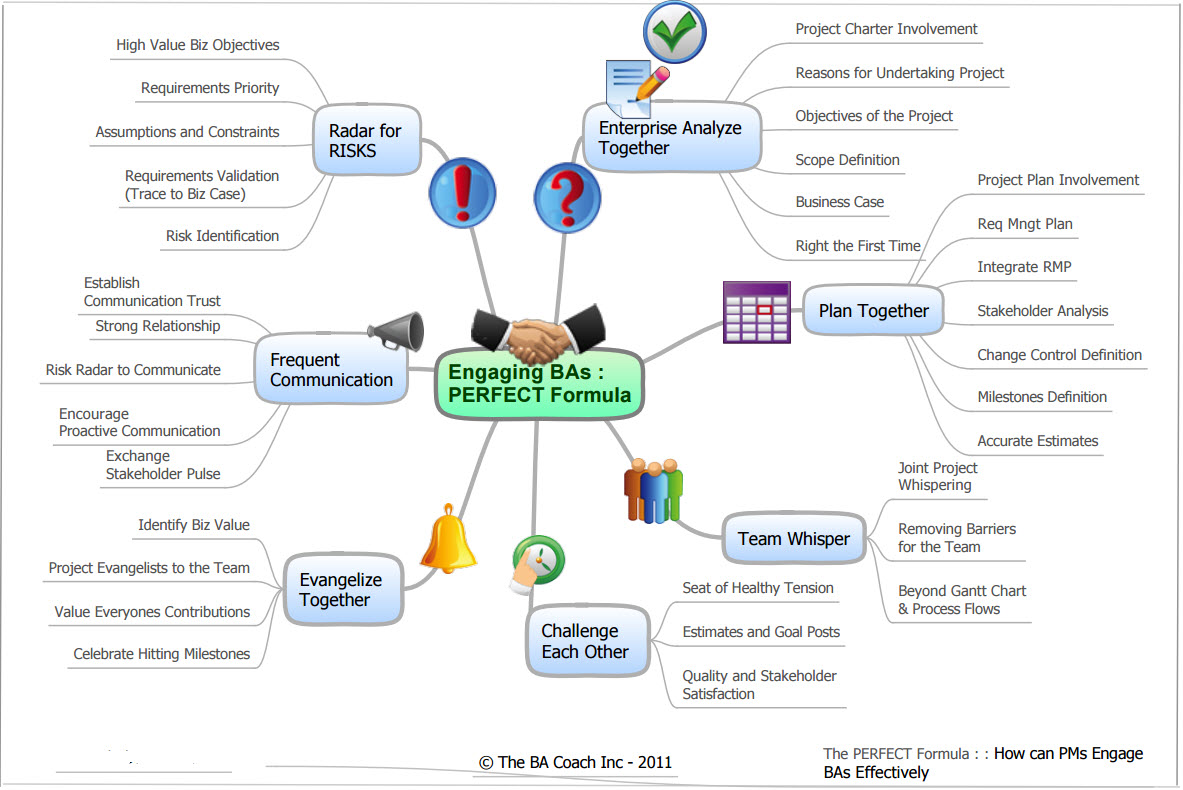
How Project Managers Can Engage Business Analysts Effectively – The PERFECT Formula
As a business analyst you can get only two distinct images of your project manager:
“A supportive and motivating project coach.”
or
“A slave driver asking the perennial question: ‘So when will you get the done? “
Sometimes, both these styles can be exhibited by the same person at various phases of the project. To a large extent, the way it surfaces depends on the personality, experience level, and the background of the project manager.
So, my questions to all the project managers out there are:
Related Article: The Project Manager vs the Business Analyst
Is there a way that the project management community can engage business analysts to improve the synergy between them?
How soon do business analysts need to be engaged in a project?
What can project managers and business analysts do together to elevate the team performance?
Well, the reason we can be perfect together is:
“We have complementing skill sets that when combined well together can produce results on time, on budget, and on scope, with every project focusing on the right business objectives, required functionality, and with desired quality.”
Too idealistic, eh?
The PERFECT Formula for Engaging Business Analysts
Well, skill set is just one side of the equation. The other more important side is that both business analysts and project managers have the shared passion for helping the business achieve its objectives. Both project managers and business analysts when collaborating well and nurturing the healthy tension that exists between them, can deliver better quality projects.
Being an obsessive, compulsive ‘acronym-ophile’, I created an acronym for “How PMs can engage their BAs” in seven different ways – PERFECT – which expands to:
1. P – Plan Together – It can be fruitful to involve a business analyst in the project planning activity. Business analysts normally create a requirements management plan (RMP), and if a project manager can work with the business analyst to integrate this into the bigger project plan, it would be a great way to involve a business analyst.
2. E – Enterprise Analyze Together – Finding out the reasons for undertaking a project together can be a great activity to increase synergy. Nailing down the scope items and objectives of the project in the project charter can become easier when a business analyst is involved. Unfortunately, most of the times a BA doesn’t get involved in the project charter creation. I would love to see this changing in the days to come.
3. R – Radar for Risks – Using business analysts as a “project radar” to sense risks in advance is another great way to involve BAs. Since they work so closely with the stakeholders, business analysts have a better understanding of the business requirements’ priority, and overall a tighter knowledge of the assumptions and constraints of the project.
4. F – Frequent Communication – It is extremely important that project managers and business analysts establish solid communication trust between each other. Relationship building is at the seat of establishing this trust. When I asked my current project manager about what is one thing she values the most in business analysts, she said, “I like it when they proactively come to talk to me.” In order for this to happen, both PMs and BAs need to establish that free flowing communication channel.
5. E – Evangelize Together – At the end of the day, both project managers and business analysts are working towards achieving a common business goal and delivering value to the business. Being project and value evangelists is another joint activity that PMs can engage their BAs in. This can mean passionately advocating the value that the project is delivering to the business, valuing everyone’s contribution, and celebrating hitting the milestones.
6. C – Challenge Each Other – This is the seat of the healthy tension that exists between the PMs and BAs. A project manager can constantly challenge the analysis, and a business analyst can reason and trace back the extended analysis to the critical business requirements. This dialogue prevents the trap of analysis paralysis, which some business analysts sometimes tend to be guilty.
7. T – Team Whisper – It is going the extra mile to be a project whisperer. It is understanding that tools and methodologies are just one side of the equation. The other, more important side, is people. A project manager can involve a business analyst to remove the barriers for the team. This is the moment when both start to look beyond the Gantt Charts and the Business Process Flows.
The PERFECT Mind Map
I hope that gave you some food for thought. I have also created a mind map to summarize some of these points and added a few other pointers.

Nothing is perfect in this world, and so is this formula for engagement. So, I now invite you to list your thoughts on this using the comments section below.
What do you think about the PERFECT Formula? Are there additional things that could be done? What would be some of the challenges that will prevent a BA/PM from applying any of the steps?
Would love to hear your thoughts!